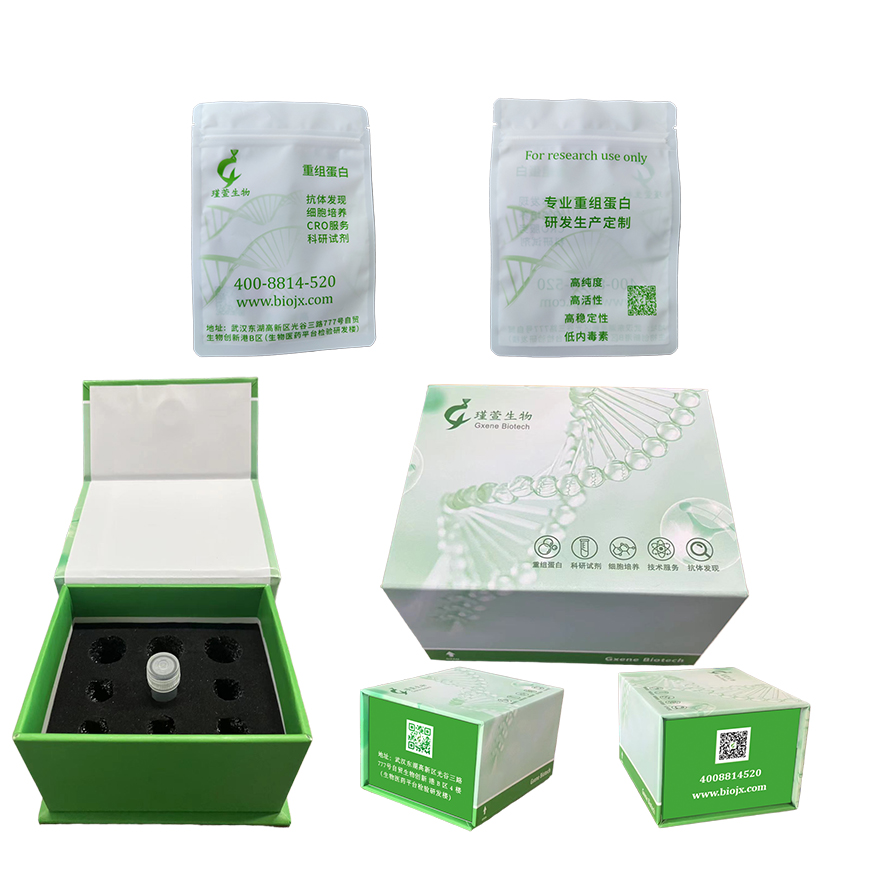研究方向
IL-12受体是与IL-12结合的I型细胞因子受体。IL-12 受体主要在 NK 和 T 细胞上表达,由 β1 和 β2 亚基组成,是 gp130 细胞因子受体超家族的成员。IL-12Rβ2(缩写为IL-12R2或IL-12Rβ2)是IL-12受体的一个亚基,IL-12Rβ2是其人类基因名称。IL-12Rβ2蛋白和IL-12Rβ1蛋白的共表达可以导致高亲和力IL-12结合位点的形成以及IL-12依赖性信号传导的重建。IL-12 与 IL-12 受体结合后,直接与 IL-12Rβ1 相互作用的细胞质蛋白 TYK2 和与 IL-12Rβ2 相互作用的 JAK2 被酪氨酸磷酸化。随后的酪氨酸磷酸化和与 IL-12Rβ2 结合的 STAT4 的激活需要磷酸化的 TYK2 和 JAK2。STAT4 是一种转录因子,随后同二聚化、易位至细胞核并与其靶 DNA 结合,激活 IFN-γ 和其他靶基因的转录。
IL- 的表达12Rβ2链被认为是控制T细胞发育和功能的关键因素。它在 Th1 细胞分化中发挥重要作用,缺失会导致 Th1 分化失败和 Th1 效应分子产生功能失调。人们发现该基因的上调与许多传染病有关,例如克罗恩病和麻风病,这些疾病被认为有助于炎症反应和宿主防御。
生物活性
Measured by its binding ability in a functional ELISA. When Recombinant Human IL‑12 is immobilized at 0.5 μg/mL, 100 μL/well, the concentration of Recombinant Human IL‑12 R beta 2 Fc that produces 50% of the optimal binding response is 0.015-0.09 μg/mL.
After reconstitution, the protein solution is stable at -20℃ for 3 months, at 2-8℃ for up to 1 week.未开盖的干粉蛋白在 -20°C至-80°C可保存12个月;
复溶之后,蛋白溶液在-20°C及以下可保存3个月,在2-8℃可保存1周。
背景信息
The high-affinity IL-12 receptor complex includes the 100-kDa IL-12 Receptor beta 1 (IL-12 R beta 1) and the 130-kDa IL-12 Receptor beta 2 (IL-12 R beta 2) subunits, both type I transmembrane proteins within the cytokine receptor superfamily. Its ligand, IL-12, is a disulfide-linked dimer of 35-kDa (IL-12 alpha p35) and 40-kDa (IL-12 beta p40) subunits. IL-12 R beta 2 binds IL-12 alpha and signals through Jak2, while IL-12 R beta 1 binds IL-12 beta and signals through Tyk2 (3). IL-12 R beta 1 is also a subunit of the IL-23 receptor complex. The 862 amino acid (aa) human IL-12 R beta 2 includes a 23 aa signal peptide, a 599 aa extracellular domain (ECD) with five fibronectin type III (Fn III) domains, 8 potential N-glycosylation sites, and a WSXWS motif, a 21 aa transmembrane domain and a 219 aa cytoplasmic region with a Box 1 motif and a tyrosine phosphorylation site that both mediate intracellular signaling. Human IL-12 R beta 2 ECD shares 69%, 67%, 79%, 81% and 82% aa sequence identity with mouse, rat, canine, porcine and bovine IL-12 R beta 2, respectively. Human and mouse IL-12 R beta 2 do not bind cross-species IL-12. A human alternatively spliced 659 aa form contains a shortened, altered cytoplasmic sequence. Unlike IL-12 R beta 1, which is constitutive in T cells, NK cells and B cells, IL-12 R beta 2 expression is more limited. IL-12 R beta 2 is expressed following STAT1 activation by IFN-gamma, IL-27 and/or T cell receptor stimulation of naïve T cells, allowing IL-12 to promote Th1, but not Th2, differentiation. Among B cells, surface expression is limited to naïve germinal center and memory B cells, and myeloma cells. Deletion of mouse IL-12 R beta 2 causes systemic overexpression of IL-6, accelerated maturation of thymocytes, deficient regulatory T cell maturation and function, and reduced splenic T cell apoptosis. These mice are susceptible to autoimmune diseases such as experimental autoimmune encephalitis and spontaneous B cell malignancies. In humans, polymorphism of the IL-12 R beta 2 gene is associated with systemic sclerosis.

